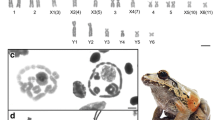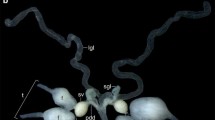Abstract
The chromosome number in the caddis-fly,Glyphotaelius pellucidus (Retz.) is: 2n ♂=60, ♀=59; n ♂=30, ♀=29, 30. The sex determining mechanism is XX-XO, the female being the heterogametic sex. The sex element is heteropycnotic at oogonial prometaphase and at oocyte pachytene. There are no chiasmata at oocyte diakinesis, whereas one or two of these occur per bivalent in the male. The smallest bivalent has a delayed pairing at spermatocyte diakinesis.
Similar content being viewed by others
References
Botosaneanu, L. (1967).Trichoptera. In:J. Illies, Limnofauna europaea, pp. 285–309. Fischer, Stuttgart.
Gresson, R. A. R. (1933). Studies on the gametogenesis ofStenophylax stellatus, Curt. (Trichoptera). — Oogenesis.Proc. Roy. Soc. Edin. 53: 322–346; pls. I–II.
Gresson, R. A. R. (1935). The spermatogenesis ofStenophylax stellatus, Curt. (Trichoptera).Quart. Journ. Micr. Sci. 78 (N.S.): 311–327; pls. XII–XIII.
Kiauta, B. (1968). Distribution of the chromosome numbers inTrichoptera in the light of phylogenetic evidence.Genen en Phaenen 12 (4): 110–113.
Klingstedt, H. (1928). Heterogametic females in two species ofTrichoptera.Mem. Soc. F. Fl. Fenn. 4: 179–182.
Klingstedt, H. (1931). Digametie beim Weibchen der TrichoptereLimnophilus decipiens Kol. nebst Erörterungen zur Theorie der Geschlechtsvererbung.Acta Zool. Fenn. 10: 1–69.
Lutman, B. F. (1910). The spermatogenesis of the caddis-fly (Platyphylax designatus Walker).Biol. Bull. 19: 56–72; pls. I–II.
Oguma, K. (1930). A comparative study of the spermatocyte chromosome in allied species of the dragonfly.J. Fac. Sci. Hokkaido Imp. Univ. (VI),1: 1–32.
Pchakadze, G. M. (1928). Untersuchungen über die Gametogenese beiTrichoptera. I. Die Spermatogenese beiAnabolia sororcula Mc. Lach. undLimnophilus affinis Curt.Arch. Russ. anat. hist. embr. 7: 191–206.
Pchakadze, G. M. (1930). Karyologische Untersuchungen an Trichopteren.Arch. Russ. anat. hist. embr. 9 (2): 227–237; 311–321; pls. I–II.
Ray Chaudhury, S. P. &J. Das Gupta (1949). Meiosis in the hemipteransSphaerodema sp. (Belostomatidae) andRiptortus sp. (Coreidae).Proc. Ind. Sci. Congr. 36 (3): 154–155.
Schmid, F. (1955). Les genresGlyphotaelius Steph. etNemotaulius Bks.Bull. Soc. Vaud. Sci. Nat. 65: 213–244.
Schmid, F. (1955).Contribution a l'étude des Limnophilidae (Trichoptera). Univ. Lausanne (Thèse).
Suomalainen, E. (1966). Achiasmatische Oogenese bei Trichopteren.Chromosoma, Berl. 18: 201–207.
White, M. J. D. (1954).Animal cytology and evolution. Cambridge Univ. Press.
Author information
Authors and Affiliations
Rights and permissions
About this article
Cite this article
Kiauta, B., Lankhorst, L. The chromosomes of the caddis-fly,Glyphotaelius pellucidus (Retzius, 1783) (Trichoptera: Limnephilidae, limnephilinae). Genetica 40, 1–6 (1969). https://doi.org/10.1007/BF01787334
Received:
Issue Date:
DOI: https://doi.org/10.1007/BF01787334




